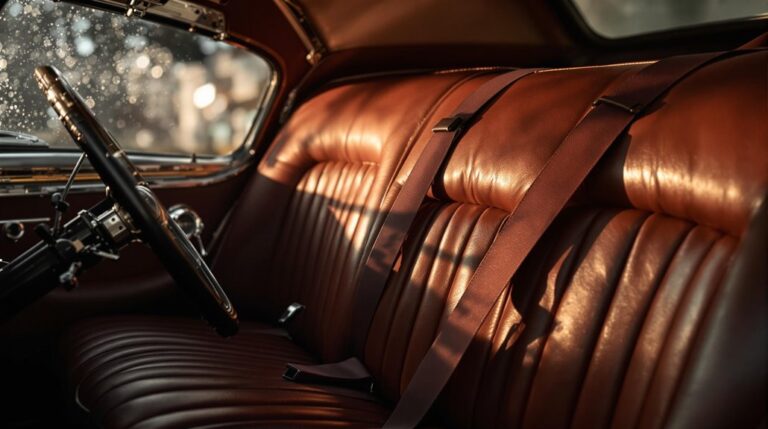Mary Anderson’s Snowy Trolley Ride: Why She Patented the Windshield Wiper
You've probably never given much thought to your windshield wipers, but in 1902, they didn't exist at all. When Mary Anderson boarded a trolley in New York City that winter, she couldn't have known her uncomfortable ride would lead to one of the most important automotive innovations in history. What she witnessed that day, and how she chose to solve the problem, would transform the future of transportation and save countless lives.
The Life of Mary Anderson Before Her Invention

Growing up in Greene County, Alabama, Mary Anderson led a life marked by entrepreneurial spirit and adaptability after her father's death in 1870.
Living with her mother Rebecca and sister Fannie on Burton Hill Plantation, she learned to be resourceful from her early influences. In a time when few women drove, she would later become an automotive pioneer.
Though she lacked formal training in mechanics or engineering, you'll find her ventures were diverse and ambitious. After moving to Birmingham in 1889, she demonstrated her business acumen by constructing the Fairmont Apartments.
A Winter Journey That Sparked Innovation
While visiting New York City in the winter of 1902, Mary Anderson witnessed a problem that would lead to her groundbreaking invention. During her trolley ride, she observed the driver repeatedly stopping to clear snow from the windshield, creating delays and safety risks.
The winter innovation emerged from watching these trolley challenges, as drivers struggled with the multi-pane windows that offered no protection against snow and sleet. Just a year later, she would receive her official patent grant for her remarkable design. Her initial design featured a spring-loaded arm with a rubber blade that effectively cleaned the glass surface.
You can picture the scene: operators opening their windows to clear the glass manually, exposing themselves to harsh elements while passengers waited.
Anderson immediately recognized the need for an automated solution that could be operated from inside the vehicle. She began sketching her idea for a blade mechanism that would revolutionize transportation by clearing precipitation from windshields efficiently and safely.
Designing the First Windshield Wiper
Back in Alabama, Mary Anderson transformed her initial observations into concrete design plans for the world's first practical windshield wiper. The wiper mechanics she envisioned were remarkably straightforward: a spring-loaded arm with a rubber blade would press against the windshield, controlled by a lever from inside the vehicle.
As the design evolution progressed, she collaborated with a professional designer and local manufacturer to refine her concept. She successfully filed for and received her patent in 1903, marking a significant milestone in automotive safety innovation.
You'll notice how she incorporated practical features like a counterweight to maintain consistent contact with the glass and a removable design for fair-weather driving. The device effectively cleared snow and rain from windows, solving a crucial visibility problem for drivers.
Despite facing skepticism about its commercial potential and concerns over driver distraction, Anderson remained focused on creating a simple, effective solution. Her design would prove revolutionary, though it was ahead of its time in the pre-automobile era.
Securing the Patent and Technical Details
Mary Anderson's design efforts culminated in her patent application on June 18, 1903, leading to the successful award of U.S. Patent No. 743,801 just five months later.
Her "Window Cleaning Device" featured innovative technical solutions to the challenges of clearing windshields in adverse weather.
You'll find her design remarkably straightforward yet effective. A spring-loaded arm with a rubber blade mounted on the vehicle's exterior connected to a manual lever inside.
The patent timeline shows she addressed several technical challenges through clever engineering: the spring mechanism provided even pressure distribution using claws, while the blade's yielding action prevented damage from obstacles. Car manufacturers remained skeptical about implementing her invention despite its clear benefits.
The device could be removed during fair weather, making it practical for daily use.
Despite these innovations, the patent expired in 1920 as Anderson struggled to find manufacturers interested in producing her invention.
The invention was later adopted by Cadillac in 1922 as standard equipment in their vehicles, proving Anderson's design was ahead of its time.
From Skepticism to Standard Safety Feature

Despite its revolutionary potential, Anderson's windshield wiper invention initially faced widespread skepticism from the automotive industry. Car manufacturers and firms like Dinning and Eckenstein dismissed its commercial value, believing the wiper's movement would distract drivers.
Public perception shifted dramatically in the 1920s when closed-car designs created a pressing need for visibility solutions. Her inspiration came during a cold winter commute when she observed the challenges faced by trolley operators. The transition from open-air to closed vehicles made effective windshield cleaning mechanisms essential for driver safety.
After Anderson's patent expired in 1920, automotive evolution accelerated rapidly. Cadillac led the charge by making wipers standard equipment in 1922, with other manufacturers quickly following suit.
The technology continued to advance, from electric motors to Bosch's worm gear drive in 1928, and later, Robert Kearns' revolutionary intermittent wipers in 1967.
Today, you'll find Anderson's once-dismissed invention on every vehicle, recognized as an essential safety feature that's saved countless lives.










